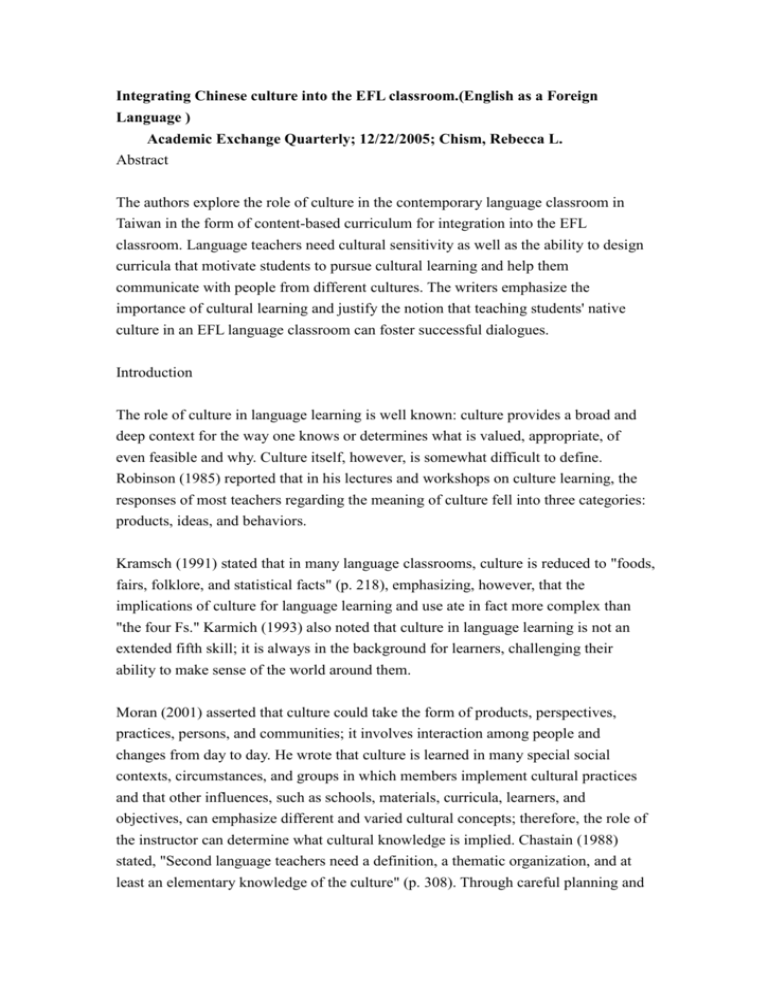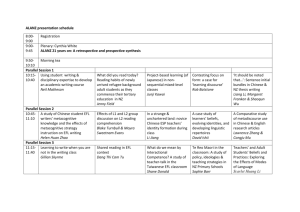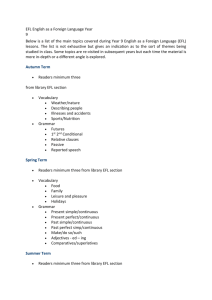Integrating Chinese culture into the EFL classroom
advertisement

Integrating Chinese culture into the EFL classroom.(English as a Foreign Language ) Academic Exchange Quarterly; 12/22/2005; Chism, Rebecca L. Abstract The authors explore the role of culture in the contemporary language classroom in Taiwan in the form of content-based curriculum for integration into the EFL classroom. Language teachers need cultural sensitivity as well as the ability to design curricula that motivate students to pursue cultural learning and help them communicate with people from different cultures. The writers emphasize the importance of cultural learning and justify the notion that teaching students' native culture in an EFL language classroom can foster successful dialogues. Introduction The role of culture in language learning is well known: culture provides a broad and deep context for the way one knows or determines what is valued, appropriate, of even feasible and why. Culture itself, however, is somewhat difficult to define. Robinson (1985) reported that in his lectures and workshops on culture learning, the responses of most teachers regarding the meaning of culture fell into three categories: products, ideas, and behaviors. Kramsch (1991) stated that in many language classrooms, culture is reduced to "foods, fairs, folklore, and statistical facts" (p. 218), emphasizing, however, that the implications of culture for language learning and use ate in fact more complex than "the four Fs." Karmich (1993) also noted that culture in language learning is not an extended fifth skill; it is always in the background for learners, challenging their ability to make sense of the world around them. Moran (2001) asserted that culture could take the form of products, perspectives, practices, persons, and communities; it involves interaction among people and changes from day to day. He wrote that culture is learned in many special social contexts, circumstances, and groups in which members implement cultural practices and that other influences, such as schools, materials, curricula, learners, and objectives, can emphasize different and varied cultural concepts; therefore, the role of the instructor can determine what cultural knowledge is implied. Chastain (1988) stated, "Second language teachers need a definition, a thematic organization, and at least an elementary knowledge of the culture" (p. 308). Through careful planning and wise course material selection, the teacher has the ability to promote cultural sensitivity and appreciation among students. Culture can be integrated into the EFL classroom when a teacher views culture as an integral part of a syllabus; furthermore, learning culture through of in conjunction with subject matter can enhance a language course. Such courses have also been called content-based because they integrate particular content with language teaching aims. Lee and VanPatten (2003) stated, "Culture as people, customs, and artifacts--is content and can be treated the same as any content in any course; teachers can use culture as content in the various kinds of activities that can be developed for communicative language teaching" (p. 5). In the language classroom, intercultural understanding is a goal as students become more aware of their own culture and knowledgeable about the target culture. In learning a new culture, learners need to purposefully construct an understanding of the other worldview, a different reality in order to speak with people from other cultures. Moran (2001) contended that culture learning is based on cultural comparison, a "process [which] runs back and forth between the learner's culture and the culture under study" (p. 126), providing a basis for comparison and contrast in the language classroom. Asking learners to describe what they know about their own culture can increase their ability to compare and contrast it with other cultures. Tomalin and Stempleski (1993) strongly advocated a task-orientation approach when teaching culture. This approach features cooperative learning tasks in which students work together in pairs or small groups to gather precise segments of information, share, and discuss what they have discovered "in order to form a more complete picture and interpret the information within the context of the target culture and in comparison with their own culture(s)" (p. 9). Activities such as these encourage interaction with other ethnic groups as well as in their own communities, promoting healthy communication and relationships. Research Rationale The goal in a language classroom is intercultural understanding, not only the understanding of another culture but of one's own culture as well. Most of the EFL teachers in Taiwan, however, ate using textbooks written by Americans and published by American's companies. Textbooks such as Interactions 1 Reading, (Hartmann & Kim, 2002), are often used by language teachers in Taiwan for teaching English. The content of books like Interaction 1, however, overemphasizes the target culture (world or American culture), while giving much less attention to Taiwanese culture. Often the result is that Taiwanese students may be able to talk about world or American culture in English but ate unable to talk about their own culture in English because it has almost never been addressed in their instruction. Chiu (1998) advocated that teachers increase the amount of Chinese culture taught in English language classrooms in order to integrate Chinese culture into EFL teaching. In this way, students become more aware of their own culture and ate able to use English to talk about it. Based on this suggestion, we propose the following lesson plan that purposefully incorporates Chinese culture into the EFL classroom asa content-based approach toward English language instruction and cultural awareness. Population This lesson is targeted toward Taiwanese university sophomores majoring in applied English. In Taiwanese schools English is regarded as subject matter; since the students are majors in applied English, they have at least a high intermediate level of language proficiency in speaking and listening. According to the curriculum reform program in Taiwan, known as the Grade 1-9 Curriculum Guideline, the new English curriculum focuses on three goals for English taught in elementary schools from Grade 3 (schools in some regions begin instruction in Grade 1): (a) to cultivate students' basic skills in English communication, (b) to cultivate students' interest and means of learning English, and (c) to promote students' understanding of native and foreign culture and customs (Zhan & Chai, 2001). Procedure/Activities In order to achieve these objectives as well as to promote students' understanding of native and foreign cultural customs, the legend of Chinese Valentine's day, as illustrated through the poem Fairy of the Magpie Bridge will be used (Appendix A). Scott and Huntington (2002) asserted that studying literature fosters students' "affective awareness and cognitive flexibility and [is] therefore effective for development of C2 competence" (p. 622). Chinese Valentine's Day is a legend about Zhi Nu, the seventh daughter of the Emperor of Heaven; and Niu Lang, an orphaned cowherd. They meet once a year on the 7th day of the 7th lunar month on the Chinese calendar on a bridge made of magpie wings over the Silver River. The Emperor had separated the pair, forcing his seventh daughter to move to the star Vega and the cowherd to the star Altair. Written by Guan Qin during the Song Dynasty (960-1279), Fairy of the Magpie Bridge is one of the most famous poems about the legend. At the end of the poem, the narrator asks why the lovers are so greedy for time to spend together when they love each other so much. The narrator does not believe that lovers must be together continuously; instead, the love itself is loyal and steadfast. Love is faith and emotional connection, not the physical attraction and desire emphasized in the story. Before the first class session, each student receives a letter from the instructor, which includes a needs assessment in order to identify students' needs and determine how much they already know. Students will then work together to translate the poem for basic understanding. The traditional foreign language teaching method known as grammar-translation focuses on developing student appreciation of literature in the target language as well as teaching the language. Its goals include the following: to "read literature in the target language; learn grammar rules and vocabulary; and develop mental acuity" (Larsen-Freeman, 2000). Deeney (1999) also recommended this approach for students to help them understand both language and culture. Also, additional websites and resources will be available for reference. Then, students will work together to prepare 15-minute oral presentation or role-play that expresses their perspectives and/or interpretation of this traditional Chinese cultural legend. After the performance, each group will pose at least three questions associated with the theme. Students will have opportunities to discuss and interact with one another, not only in class but also outside of the classroom, as Deeney (1999) suggested, via e-mail exchange of data. Students' responses using this type of communication are less formal than the writing mode and provide them with more time and opportunity to share their thoughts and findings. After the cultural presentations, the instructor will show a videotape of American culture relevant to the theme and ask them to write a short reflection/discussion in order to assess the degree to which they understood the similarities and differences between the two cultures. To assess the cultural presentations, each student will submit a two-page, double-spaced, word-processed description in English of his or her oral or dramatic presentation. Students will then translate new vocabulary and phrases in Chinese and use three sentences patterns in their papers that exemplify the grammar rules studied in class. In this manner, the instructor will assess the students' overall speaking and writing proficiency and improvement, their reading and listening proficiency and improvement, and their grammar skills. In addition, since the presentations will be videotaped, students can assess themselves in order to improve their language skills for future performances. Finally, the instructor will employ a Classroom Critical Incident Questionnaire (Brookfield, 1995) to obtain their feedback on the lesson; Brookfield stated that one of most vital elements in any career in education is the teacher's ability to see herself or himself through students' eyes. When we do this, we also learn; moreover, in this way, we are modeling behavior for our students. Reflection Although this lesson has not yet been field tested, the authors believe that the plan can be effective in culture learning for the target Taiwanese students. It also can be developed as a future research project in order to more completely examine its potential asa means to facilitate cultural learning and teaching in a language classroom. Additional questionnaires and/or surveys can be used to triangulate its effectiveness toward a better cultural awareness of others as well asa deeper understanding of their own culture. Lado (1997) stated, "We must have an understanding of our own culture before we can compare it with others" (p. 4). Through this lesson Taiwanese students will be better able to share their own native culture with foreigners, and they will be more open to appreciating cultural differences; thus, increasing their cross-cultural learning. Deeney (1999) pointed out that "anyone seriously engaged in cross-cultural communication tends to become a comparativist" (p. 60). The lesson plan comprises various dimensions: It begins with a traditional Chinese love story and a poem for literary appreciation and then proceeds into intercultural awareness. Most importantly, this lesson allows the instructor to guide Taiwanese students to appreciate their own traditional culture and facilitate their expression of their cultural perspective in English, demonstrating how one's own cultural knowledge and awareness can be used as a reference for mutual understanding, competence, and communication. Conclusion Clearly, students' native culture can be effectively integrated into the EFL classroom as a basis for comparison and contrast as well asa means of second of foreign language acquisition. In this particular instance, the use of Chinese culture not only provides content that students are already familiar with, but also a means to develop language skills while communicating with and educating others. In addition, students have the opportunity to develop cultural sensitivity and appreciation, adding to their motivation to be able to interact with others whose cultures are different from theirs. It goes without saying that the teacher plays a key role in culture teaching and learning in EFL classrooms. Course materials effectively used and carefully planned by teachers are important considerations toward the effective integration of culture into a content-based curriculum. Appendix A Fairy of the magpie bridge By Guan Qin Translated by Kylie Hsu Among the beautiful clouds, Over the heavenly river, Crosses the weaving maiden. A night of rendezvous, Across the autumn sky, Surpasses joy on earth. Moments of tender love and dream, So sad to leave the magpie bridge. Eternal love between us two, Shall withstand the time apart. References Brookfield, S. D. (1995). Becoming a critically reflective teacher. San Francisco: Jossey-Bass. Chastain, K. (1988). Developing second-language skills: Theory to practice. Orlando, FL: Harcourt. Chiu, Mei-ho. (1998). Incorporating Chinese cultural aspects into English Language Teaching. Proceedings of 1998 Conference of Schools of Foreign Languages and Cultures, Soochow University: Culture Awareness in Language Education. Taipei: Soochow University Press. Deeney, J. (1999). Teaching western literature to Chinese students. Journal of Asian Pacific Communication, 9(1 & 2), 57-71. Hinkel, E. (1999). Introduction: Culture in research and second language pedagogy. In E Hinkel, (Ed.), Culture in second language teaching and learning (pp. 1-7). New York: Cambridge University Press. Hartmann, P. & Kim, E. (2002). Interactions 1: Reading, (4th ed). New York: McGraw-Hill/Contemporary Press. Kramsch, C. (1991). Culture in language learning: A view from the United States. In K. D. Bot, R. B. Ginsberg, & C. Kramsch (Eds.), Foreign language research in cross-cultural perspective (p. 217-240). Philadelphia: Benjamins. Kramsch. C. (1993). Context and culture in language teaching. New York: Oxford University Press. Lado, R. (1997). How to compare two cultures. In P. R. Heusinkveld (Ed.). Pathways to culture: Readings on teaching culture in the foreign language class. Yarmouth, ME: Intercultural Press Larsen-Freeman, D. (2000). Techniques and principles in language teaching (2nd ed.). New York: Oxford University Press. Lee, J. F., & VanPatten, B. (2003). Making communicative language teaching happen. (2nd ed.). New York: McGraw-Hill Press. McGraw-Hill Press. Il Press. Moran, P. R. (2001). Teaching culture: Perspectives in practice. Boston: Heinle & Heinle Press. Qin, Guan. Fairy of the magpie bridge. (Kylie Hsu, Trans.). Retrieved July 10, 2005, from http://www.calstatela.edu/faculty/khsu2/poetry3.html Robinson, G. L. N. (1985). Crosscultural understanding: Processes and approaches for foreign language, English asa second language and bilingual educators. New York: Pergamon Press. Scott, V. M., & Huntington, J. A. (2002). Reading culture: Using literature to develop C2 competence. Foreign Language Annals, 35(6), 622-631. Tomalin, B., & Stempleski, S. (1993). Cultural awareness. New York: Oxford University Press. Zhan, Z. Y., & Chai, J. H. (2001). Grade 1-9 Curriculum reform and teacher action research. In Association of Curriculum and Instruction/ROC (Ed.), Action research and reform of curriculum instruction (pp. 75-100). Taipei: Yang Zhi. http://www.calstatela.edu/faculty/khsu2/poetry3.html http://app1.chinadaily.com.cn/star/2002/0815/cu18-1.html http://chineseculture.about.com/od/culturesociety/ http://chineseculture.miningco.com/bl_index.htm Wen-Ling Lou, Kent State University Rebecca L. Chism, Kent State University Wen-Ling Lou is a doctoral candidate in curriculum and instruction in Foreign Language Education, and Rebecca L. Chism, Ph.D. is an assistant professor of Foreign Language Pedagogy at Kent State University. COPYRIGHT 2005 Rapid Intellect Group, Inc.







